[English] 日本語
 Yorodumi
Yorodumi- PDB-7f9u: Toxoplasma gondii Prolyl-tRNA Synthetase (TgPRS) in Complex with ... -
+ Open data
Open data
- Basic information
Basic information
| Entry | Database: PDB / ID: 7f9u | ||||||
|---|---|---|---|---|---|---|---|
| Title | Toxoplasma gondii Prolyl-tRNA Synthetase (TgPRS) in Complex with inhibitor T35 and Halofuginone | ||||||
 Components Components | Prolyl-tRNA synthetase (ProRS) | ||||||
 Keywords Keywords | LIGASE/LIGASE INHIBITOR / PROTEIN TRANSLATION / INHIBITOR / PRS / ATP POCKET / DOUBLE DRUG / LIGASE / LIGASE-LIGASE INHIBITOR complex | ||||||
| Function / homology |  Function and homology information Function and homology informationproline-tRNA ligase / proline-tRNA ligase activity / prolyl-tRNA aminoacylation / aminoacyl-tRNA synthetase multienzyme complex / aminoacyl-tRNA deacylase activity / ATP binding / metal ion binding / cytoplasm Similarity search - Function | ||||||
| Biological species |  | ||||||
| Method |  X-RAY DIFFRACTION / X-RAY DIFFRACTION /  SYNCHROTRON / SYNCHROTRON /  MOLECULAR REPLACEMENT / Resolution: 2.8 Å MOLECULAR REPLACEMENT / Resolution: 2.8 Å | ||||||
 Authors Authors | Manickam, Y. / Malhotra, N. / Sharma, A. | ||||||
 Citation Citation |  Journal: To Be Published Journal: To Be PublishedTitle: TgPRS with double inhibitors Authors: Malhotra, N. / Manickam, Y. / Sharma, A. | ||||||
| History |
|
- Structure visualization
Structure visualization
| Structure viewer | Molecule:  Molmil Molmil Jmol/JSmol Jmol/JSmol |
|---|
- Downloads & links
Downloads & links
- Download
Download
| PDBx/mmCIF format |  7f9u.cif.gz 7f9u.cif.gz | 788 KB | Display |  PDBx/mmCIF format PDBx/mmCIF format |
|---|---|---|---|---|
| PDB format |  pdb7f9u.ent.gz pdb7f9u.ent.gz | 648.9 KB | Display |  PDB format PDB format |
| PDBx/mmJSON format |  7f9u.json.gz 7f9u.json.gz | Tree view |  PDBx/mmJSON format PDBx/mmJSON format | |
| Others |  Other downloads Other downloads |
-Validation report
| Summary document |  7f9u_validation.pdf.gz 7f9u_validation.pdf.gz | 2.5 MB | Display |  wwPDB validaton report wwPDB validaton report |
|---|---|---|---|---|
| Full document |  7f9u_full_validation.pdf.gz 7f9u_full_validation.pdf.gz | 2.5 MB | Display | |
| Data in XML |  7f9u_validation.xml.gz 7f9u_validation.xml.gz | 65.7 KB | Display | |
| Data in CIF |  7f9u_validation.cif.gz 7f9u_validation.cif.gz | 90.3 KB | Display | |
| Arichive directory |  https://data.pdbj.org/pub/pdb/validation_reports/f9/7f9u https://data.pdbj.org/pub/pdb/validation_reports/f9/7f9u ftp://data.pdbj.org/pub/pdb/validation_reports/f9/7f9u ftp://data.pdbj.org/pub/pdb/validation_reports/f9/7f9u | HTTPS FTP |
-Related structure data
| Related structure data |  7f9pC  7f9qC  7f9rC 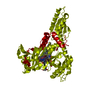 7f9sC  7f9tC  7f9vC 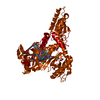 7vc5C  5xiqS S: Starting model for refinement C: citing same article ( |
|---|---|
| Similar structure data | Similarity search - Function & homology  F&H Search F&H Search |
- Links
Links
- Assembly
Assembly
| Deposited unit | 
| ||||||||
|---|---|---|---|---|---|---|---|---|---|
| 1 | 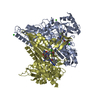
| ||||||||
| 2 | 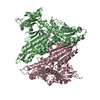
| ||||||||
| Unit cell |
|
- Components
Components
-Protein , 1 types, 4 molecules ABCD
| #1: Protein | Mass: 57937.258 Da / Num. of mol.: 4 Source method: isolated from a genetically manipulated source Source: (gene. exp.)   |
|---|
-Non-polymers , 6 types, 72 molecules 
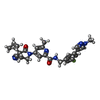
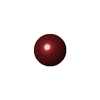








| #2: Chemical | ChemComp-HFG / #3: Chemical | ChemComp-1TI / #4: Chemical | #5: Chemical | #6: Chemical | ChemComp-CL / #7: Water | ChemComp-HOH / | |
|---|
-Details
| Has ligand of interest | Y |
|---|
-Experimental details
-Experiment
| Experiment | Method:  X-RAY DIFFRACTION / Number of used crystals: 1 X-RAY DIFFRACTION / Number of used crystals: 1 |
|---|
- Sample preparation
Sample preparation
| Crystal | Density Matthews: 2.55 Å3/Da / Density % sol: 51.85 % |
|---|---|
| Crystal grow | Temperature: 293 K / Method: vapor diffusion, hanging drop / pH: 8.5 Details: 0.06 M Divalents (0.3M Magnesium chloride hexahydrate, 0.3M Calcium chloride dihydrate ), 0.1 M Buffer (Sodium HEPES, MOPS), 30% v/v Precipitant (40% v/v Ethylene glycol, 20% w/v PEG 8000) |
-Data collection
| Diffraction | Mean temperature: 100 K / Serial crystal experiment: N |
|---|---|
| Diffraction source | Source:  SYNCHROTRON / Site: SYNCHROTRON / Site:  Diamond Diamond  / Beamline: I03 / Wavelength: 0.9762 Å / Beamline: I03 / Wavelength: 0.9762 Å |
| Detector | Type: DECTRIS EIGER2 XE 16M / Detector: PIXEL / Date: Jul 17, 2019 |
| Radiation | Protocol: SINGLE WAVELENGTH / Monochromatic (M) / Laue (L): M / Scattering type: x-ray |
| Radiation wavelength | Wavelength: 0.9762 Å / Relative weight: 1 |
| Reflection twin | Operator: h,-k,-l / Fraction: 0.15 |
| Reflection | Resolution: 2.8→100.93 Å / Num. obs: 56889 / % possible obs: 100 % / Redundancy: 14.1 % / CC1/2: 1 / Net I/σ(I): 10.6 |
| Reflection shell | Resolution: 2.8→2.85 Å / Redundancy: 14.2 % / Mean I/σ(I) obs: 4.4 / Num. unique obs: 2092 / CC1/2: 0.9 / % possible all: 99.7 |
- Processing
Processing
| Software |
| ||||||||||||||||||||||||||||||||||||||||||||||||||||||||
|---|---|---|---|---|---|---|---|---|---|---|---|---|---|---|---|---|---|---|---|---|---|---|---|---|---|---|---|---|---|---|---|---|---|---|---|---|---|---|---|---|---|---|---|---|---|---|---|---|---|---|---|---|---|---|---|---|---|
| Refinement | Method to determine structure:  MOLECULAR REPLACEMENT MOLECULAR REPLACEMENTStarting model: 5XIQ Resolution: 2.8→76.573 Å / Cross valid method: THROUGHOUT / σ(F): 3.47 / Phase error: 26.32 / Stereochemistry target values: TWIN_LSQ_F
| ||||||||||||||||||||||||||||||||||||||||||||||||||||||||
| Solvent computation | Shrinkage radii: 0.9 Å / VDW probe radii: 1.11 Å / Solvent model: FLAT BULK SOLVENT MODEL | ||||||||||||||||||||||||||||||||||||||||||||||||||||||||
| Displacement parameters | Biso max: 215.66 Å2 / Biso mean: 33.3552 Å2 / Biso min: 13.44 Å2 | ||||||||||||||||||||||||||||||||||||||||||||||||||||||||
| Refinement step | Cycle: final / Resolution: 2.8→76.573 Å
| ||||||||||||||||||||||||||||||||||||||||||||||||||||||||
| LS refinement shell | Refine-ID: X-RAY DIFFRACTION / Rfactor Rfree error: 0 / Total num. of bins used: 7
| ||||||||||||||||||||||||||||||||||||||||||||||||||||||||
| Refinement TLS params. | Method: refined / Origin x: 38.9614 Å / Origin y: -1.0273 Å / Origin z: 15.9088 Å
| ||||||||||||||||||||||||||||||||||||||||||||||||||||||||
| Refinement TLS group | Selection details: all |
 Movie
Movie Controller
Controller


 PDBj
PDBj







